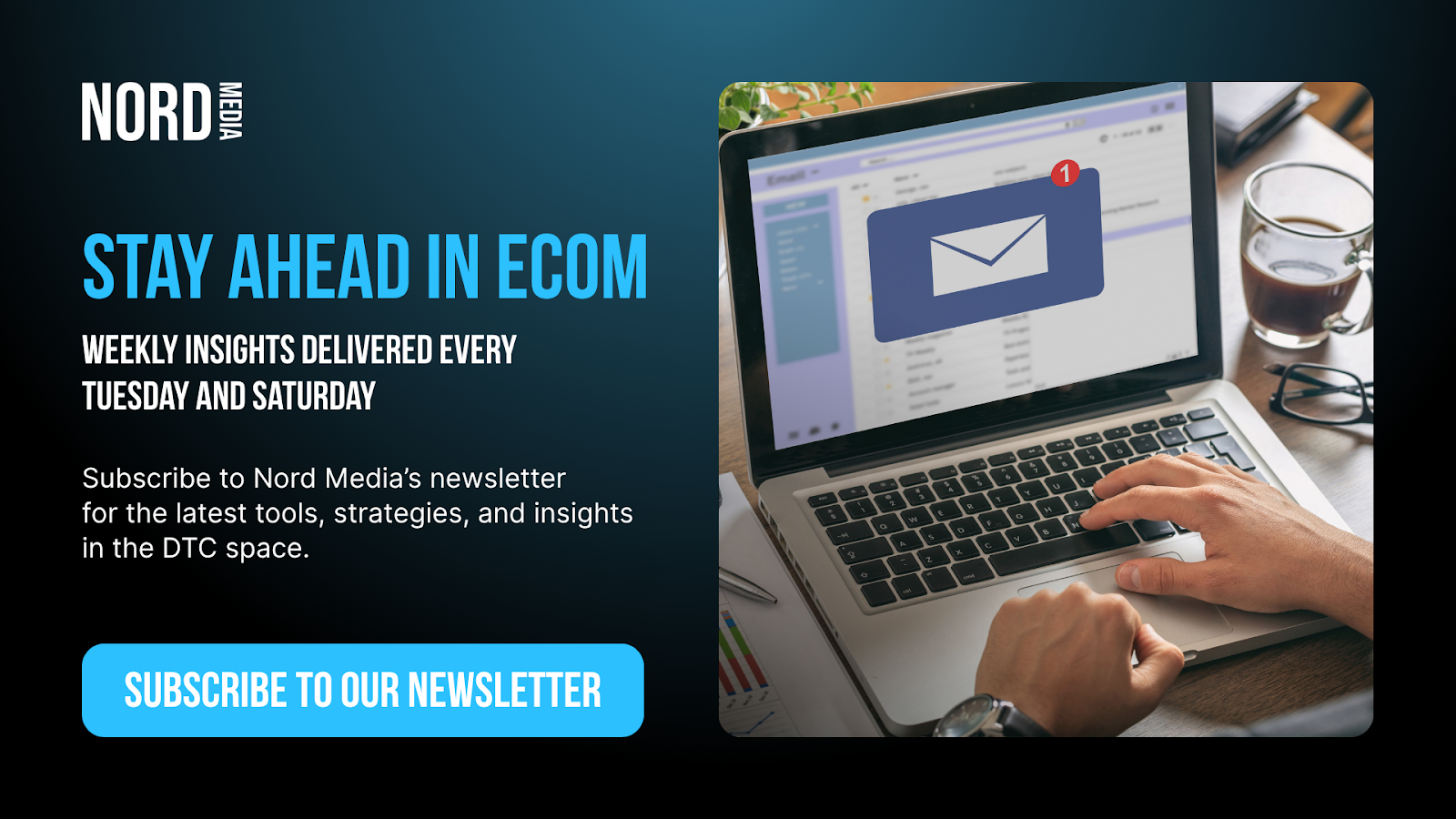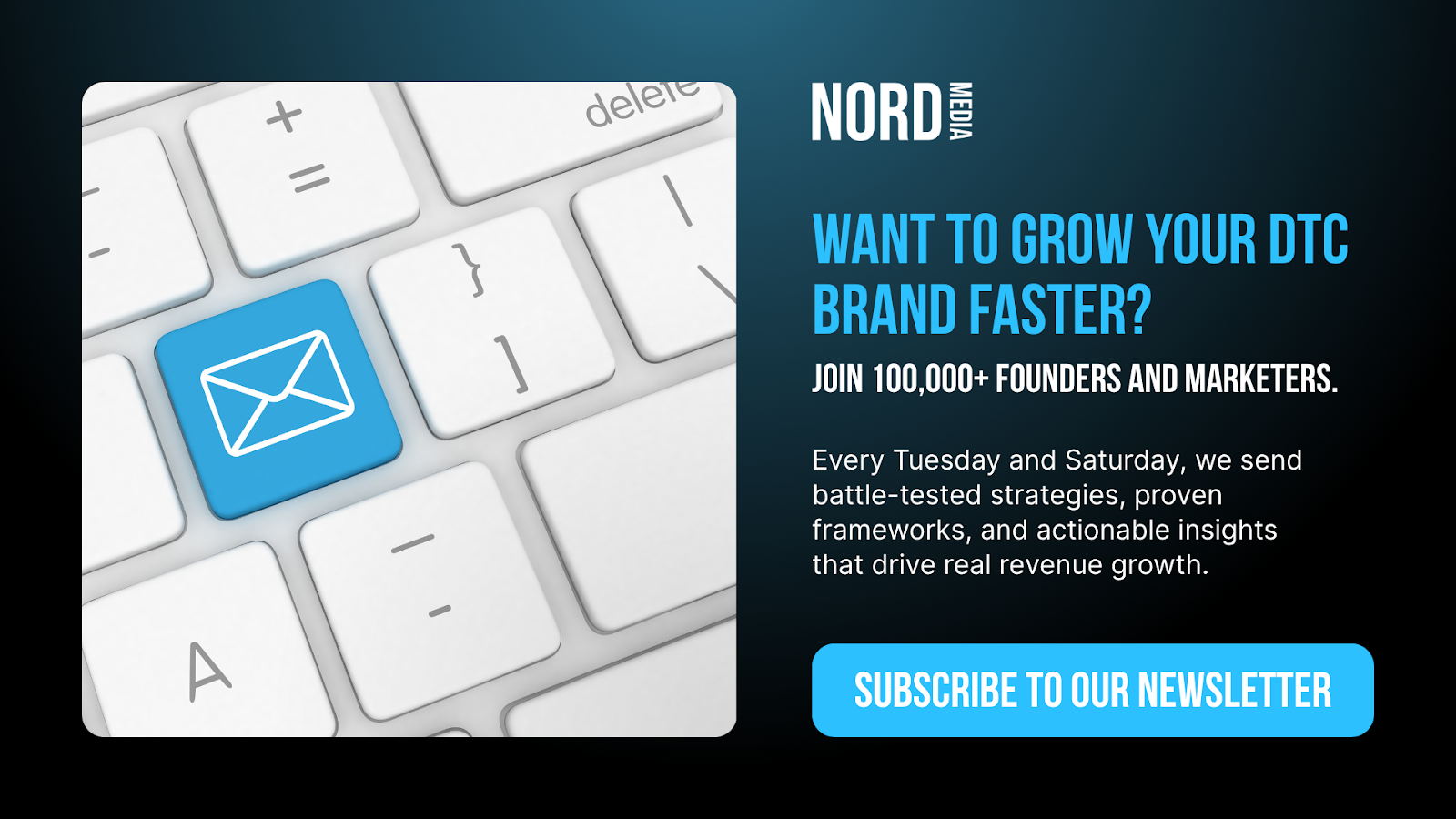Key Takeaways:
- Treat Facebook Ads as a System, Not a Slot Machine: Focus on a methodical, data-driven approach to campaigns, targeting, and creative, rather than relying on guesswork.
- Creative Is King: High-quality, engaging creative, especially vertical video, drives 70–80% of ad performance by grabbing attention and lowering costs.
- Structure Your Data for Success: Ensure your pixel and Conversion API are correctly set up and you're optimizing for revenue-focused events to give the algorithm the strongest possible signals.
Building a DTC brand today means competing where attention is currency and distribution decides winners. If you understand how the system works, Facebook and Instagram remain the most powerful performance channels for acquiring customers at scale. Most brands don’t. They boost posts, copy competitors, and toggle random targeting, then wonder why CAC spikes.
This guide explains how Facebook ads work: the auction, delivery system, creative signals, targeting structure, and the feedback loops that shape cost and performance. At Nord Media, we’ve managed over $200M in ad spend, and the lesson is clear: brands that scale are the ones that treat Facebook as a system, not a slot machine, feeding it high-quality creative, clean signals, and funnels that convert.
What Is Facebook Advertising And Why Is It Essential For DTC Brands?
Facebook advertising is a paid marketing channel that allows brands to run targeted campaigns across Facebook and Instagram, reaching billions of users with tailored messages, creatives, and offers.
Ads are delivered through Meta’s algorithm-driven auction system, where relevance, creative quality, and conversion signals determine performance, not just budget size. For many brands, choosing the right partner like a facebook advertising agency is the first step to getting results faster.
Why Is It Essential For DTC Brands?
For DTC (Direct-to-Consumer) brands, Facebook advertising is essential because it provides scale, precision, and measurable growth. It allows emerging brands to bypass traditional retail, build direct customer relationships, and compete with bigger players by efficiently targeting high-intent audiences. Done right, it’s more than impressions; it’s a full-funnel ecommerce growth strategy that drives awareness, lowers CAC, and maximizes lifetime value.

Understanding The Facebook Ads Ecosystem: Campaigns, Ad Sets, And Ads
Facebook’s ad platform is built like a funnel within a funnel: strategy at the top, control in the middle, execution at the bottom. If you understand how Campaigns, Ad Sets, and Ads stack, you can make smarter decisions, scale faster, and avoid the “set-and-pray” trap that burns budgets without learning.
Campaigns: Objective And Optimization Rules Of The Game
Campaigns define what you optimize for: conversions, sales, leads, or reach. The system finds users most likely to take that action, so picking the wrong objective skews data. This is also where you control budget distribution through Campaign Budget Optimization (CBO). When done right, CBO accelerates scale; when done poorly, it amplifies noise. Knowing how much do Facebook ads cost will help you budget effectively and align spend with objectives.
Ad Sets: Targeting, Budget, Bidding, And Placement
Ad sets control who sees ads, how much you spend, and where ads run.
- Audiences: Broad, interest, lookalike, or custom. Broad works with strong creative; lookalikes need quality seed data; custom powers retargeting.
- Budget/Bid: Daily vs. lifetime pacing. Lowest cost for testing, cost cap for CPA control, bid cap for tighter limits.
- Conversion Event: Optimize for true outcomes (e.g., Purchase, not Add to Cart).
- Placements: Advantage+ for scale; manual if creative is platform-specific.
Each ad set should isolate one variable to track impact.
Ads: Creative, Formats, And Message-To-Market Fit
Creative determines whether users stop, engage, and convert.
- Hook/First Frame: Must grab attention in under three seconds.
- Proof/Specificity: Use testimonials, quantified outcomes, and clear benefits.
- Format: Build for vertical video (9:16); UGC, demos, and comparisons often outperform polished spots.
- Offer/CTA: Strong offers with clear calls to action, consistent with the landing page.
Test hooks, angles, and offers quickly, keep winners, cut losers.
How These Layers Work Together
Campaigns tell the system what success looks like. Ad sets define the constraints and hypotheses to reach it. Ads do the heavy lifting by earning attention and action. When performance degrades, diagnose from the bottom up: creative fatigue first, audience and bidding, then objective alignment. This sequence reduces false fixes and protects learning.
How Do Facebook Ads Work? A Step-By-Step Guide for Beginners
Getting Facebook ads to perform isn’t magic; it’s a system. If you understand the mechanics and make decisions based on data, you’ll avoid burning budget and start compounding returns. Here’s the sequence that actually matters.
Step 1: Define Clear Objectives
Pick the goal tied to revenue, sales for purchases or leads for acquisition. Avoid Awareness unless it maps to business outcomes.
Step 2: Install Pixel & Conversions Api
Set up Meta Pixel + CAPI with key events (ViewContent, AddToCart, Purchase). Verify they fire correctly; optimization fails without this.
Step 3: Structure For Signal Density
Fewer, broader ad sets concentrate data. Consolidate budgets and split only by distinct goals, not minor audience tweaks.
Step 4: Build High-Impact Creatives
Hook in 3 seconds, show value fast, use captions. Test angles: problem-solution, proof, unboxing, offers. Creative drives 70–80% of results.
Step 5: Set Budgets & Bids Smartly
Budget for ~50 conversions/week. Start with auto-bidding; use cost/bid caps only with stable CPA benchmarks. Don’t starve on $5/day.
Step 6: Test Methodically
Test one variable at a time. Run until learning ends (~7 days/50 conversions). Kill losers quickly; let winners run.
Step 7: Optimize The Funnel
Strong CTR but weak CPA? Fix the landing page, checkout, or offers. Ads can’t fix funnel leaks.
Step 8: Scale With Control
Increase budgets gradually. Duplicate only if scaling breaks. Refresh creatives weekly to fight fatigue. Track blended CAC, not just ROAS.
Step 9: Measure What Matters
Use modeled attribution + first-party data. Track MER (revenue/ad spend) to guide profitable, compounding growth.

Mastering Audience Targeting: The Key To Facebook Ads Success
If you want Facebook to print money, you need clean targeting. Not “boosted posts” and wishful thinking, structured audiences, tested methodically, and pruned ruthlessly. The algorithm is robust, but it’s only as smart as the signals you feed it. Start with broad, push into qualified segments, and let data kill your darlings.
Start Broad To Train The Algorithm
Resist the urge to overfilter on Day 1. Use broad targeting with strong creative and conversion-optimized objectives. This allows the system to find pockets of performance while your pixel learns who buys, not just who clicks.
Layer With High-Intent Lookalikes
Once you have conversion data, build lookalikes from purchasers, subscription starters, and high-LTV cohorts. Prioritize smaller, higher-quality seeds over bloated event pools. Test multiple percentages (1%–5%) and let CPAs dictate which scales.
Retarget With Purpose, Not Clutter
Retarget users who started checkout, viewed product pages, or engaged with your top-performing creatives. Segment windows by intent and recency, 7-day and 14-day pools often convert best. Exclude recent purchasers to avoid burning budget.
Control Frequency And Creative Fatigue
Targeting without rotation is just noise. Watch frequency and first-time impression ratios. Refresh hooks, formats, and offers before performance decays. When frequency spikes and CTR dips, you’re paying for stale impressions.
Normalize For Signal Quality
Optimize for purchases, not vanity events. Ensure your pixel events are properly mapped, deduped, and firing consistently across the web and app. Weak signals force the algorithm to optimize for the wrong users and outcomes.
Use Exclusions To Protect Efficiency
Exclude past purchasers when prospecting. Exclude retargeting audiences from prospecting sets to prevent overlap and inflated costs. Clean audience architecture avoids cannibalization and clarifies which segment is actually pulling weight.
Scale With Structure, Not Chaos
When a segment hits target CPA, duplicate into a new ad set or expand the lookalike percentage. Avoid stacking every audience into a single catch-all. Keep tests isolated so winners are obvious and budgets can be confidently promoted.
This is also where knowing the differences in google ads vs facebook ads can guide your overall ad spend strategy. Some audiences may be cheaper to reach on Google, while others scale better on Meta.
Optimizing Your Facebook Ads: Budgets, Bidding, And Metrics
You don’t scale by guessing. You scale by structuring budgets, letting the algorithm learn, and measuring what actually moves revenue. With expert paid media management, you can ensure that every dollar is optimized for efficiency and growth.
Start With Budget Allocation That Matches Signal Density
If you’re under 50 conversions per week per ad set, you’re starving the algorithm. Consolidate into fewer ad sets and push budget to the best-performing audiences and creatives. Use campaign budget optimization when you have multiple strong ad sets; use ad set budgets when you need control during testing.
Choose The Right Bid Strategy For Your Goal
If you’re optimizing for purchases, start with the lowest cost while you build signal. When you hit stable performance and want tighter cost control, test cost caps with caps anchored to your breakeven CPA. For high-velocity promos, bid caps can win auctions aggressively but demand vigilant monitoring. Switch carefully; each strategy changes delivery behavior and learning.
Structure For The Learning Phase—And Protect It
Make one change at a time. Touching budgets or creative resets learning and tanks stability. Once you see consistent CPA and conversion volume, scale with 10–20% incremental increases every 48–72 hours. Create a duplicate with the higher budget for bigger moves and let the winner prove it.
Read Metrics Like A Profit And Loss Statement
Track the full chain: CTR (link) to CPC to CVR to CPA to MER/ROAS. If CTR is low and CPM is fine, it’s a creative problem. If CPC is strong but CVR is weak, it’s an offer or landing page problem. Diagnose, then fix the real bottleneck; don’t just raise budgets.
Creative Drives Cpm; Relevance Drives Margin
Strong hooks and clear offers lift engagement, which lowers CPM and compounds returns. Refresh creatives weekly at minimum spend levels to prevent fatigue. Kill assets with rising CPA and declining thumbstop within 72 hours; scale those that sustain strong first-3-second engagement and purchase rate.
Use Breakout Audiences, Not Endless Micro-Targets
Broad works when your pixel has a signal, and the creative is clear. Layer lookalikes once you have enough purchasers. Retarget warm site visitors and engagers with specific offers and shorter attribution windows. Keep frequency in check, above 3–4 on static cold audiences usually signals fatigue.
Align Attribution Windows With Buying Cycles
Short windows (1-day click) give tight feedback loops for fast purchases; longer windows (7-day click) capture considered buys. Evaluate performance using the window reflecting your buying behavior, then validate with blended metrics to avoid over-crediting.
Scale Only What’s Proven
Hold the line: stable CPA, sufficient conversion volume, and consistent ROAS over 3–5 days before scaling. Add budget to winners, not portfolios. If performance slips after a scale, revert immediately and diagnose whether the break was creative decay, audience saturation, or seasonality.
The Next Steps: Scaling Your DTC Brand's Facebook Ads Strategy
You’ve validated product and market fit, and your ads are generating consistent results. Now, the work gets harder and more rewarding. Scaling isn’t about pouring more budget into what worked last week. It’s about operationalizing the pieces that drive profitable volume while protecting efficiency.
Lock In Measurement Before You Scale
Clean data is the spine of scale. Ensure your pixel and Conversion API are correctly implemented, events are prioritized, and attribution windows reflect your buying cycle. Build a source of truth: compare platform-reported ROAS with blended MER to scale without getting fooled by noisy platform signals.
Systematize Creative At Volume
Creative fatigue kills momentum. Move to a production cadence where concepts, iterations, and hooks are tested weekly. Treat each ad like a hypothesis, one variable per test. Use a library of proven formats (UGC, founder-led, problem/solution, demos) and rotate winners into fresh shells to extend lifespan without losing performance.
Structure Campaigns For Control And Learning
Use a clean account structure that separates prospecting from retargeting and protects spend for learning:
- Keep budgets consolidated to stabilize delivery and speed up signal learning.
- Leverage broad targeting once creative wins, letting the algorithm hunt.
- Maintain a control campaign with evergreen winners to anchor performance while you test.
Scale Budget Without Breaking Efficiency
Increase budgets methodically. Push soft raises on stable ad sets (10–20% every 48–72 hours), or duplicate into higher budgets when you need velocity. Watch CPA and first-click MER over the next 3–5 days. If efficiency degrades, revert and diagnose: audience saturation, creative fatigue, or auction volatility.
Optimize The Full Funnel, Not Just The Click
Scaling ads exposes funnel leaks. Tighten landing pages, speed, and offer clarity. Align creative claims with landing page messaging. Test post-purchase upsells and email/SMS flows to lift LTV, enabling higher CAC ceilings without sacrificing payback periods.
Build Seasonal And Offer Readiness
Plan promos and launches a month out. Preload warm audiences, spin up creative for each phase (tease, launch, sustain), and align inventory with projected demand. Use waitlists and pre-purchase signals to prime algorithms ahead of budget surges.
Create Guardrails And Kill Criteria
Define thresholds before you scale: acceptable CPA, minimum ROAS, and time-to-signal per test. If an ad set doesn’t hit green lights within the window, cut it. Protect capital for winners. Consistency beats hero spikes.
Institutionalize Learnings
Document what works: hooks, angles, formats, audiences, landing pages. Turn wins into playbooks your team can deploy across campaigns and markets. Scale is repeatable when the system is.
Partnering with a meta ads agency at this stage can help you systematize testing, scale faster, and keep performance compounding.

Final Thoughts
When approached as a system, not a gamble, Facebook and Instagram advertising remain DTC brands' most powerful growth engines. Success comes from feeding the algorithm clean data, testing creative relentlessly, and scaling with discipline. By mastering the mechanics, objectives, signals, targeting, and funnel optimization, you'll transform Facebook ads from a cost center into a compounding growth driver. With structure and strategy, even beginner brands can compete, scale, and build loyal customer bases at speed.
Read also:
- Facebook Ads Pricing Explained: What You’ll Really Pay Per Click Or Impression
- The Ultimate Ecommerce Growth Strategy: How To Scale Profitably In 2025
- What Is Paid Media And Why It’s Essential For Scaling Your Online Store
Frequently Asked Questions About How Do Facebook Ads Work? A Beginner’s Guide For DTC Marketing
How much do 1000 clicks cost on Facebook?
It varies by industry, audience, and creative. Expect roughly 200–200–200–1,500 clicks (0.20–0.20–0.20–1.50 CPC) for 1,000 clicks. For competitive niches, the CPC can exceed $2. Strong creative and targeting can cut costs significantly.
What is the 3-2-2 method of Facebook ads?
A practical testing system: 3 audiences, 2 creatives per audience, 2 hooks/variations per creative. It accelerates learning, isolates winners quickly, and reduces wasted spending, ideal for early validation.
What is the 3-second rule on Facebook?
You have 3 seconds to earn attention. Your hook, headline, first line, or opening frame, must stop the scroll and communicate value instantly. If they don’t get it in 3 seconds, they’re gone.
How many seconds should a Facebook ad be?
For cold audiences: 6–15 seconds for video is a strong baseline. For mid/bottom-funnel or higher-consideration products: 15–30 seconds with tighter editing. Prioritize the first 3 seconds regardless of length.
What is the 20 percent rule on Facebook?
Historically, Facebook penalized ads with text covering more than 20% of the image. The strict rule is gone, but the best practice remains: keep text minimal to avoid reduced reach and maintain clarity.
What is the 24-1 rule on Facebook?
A creative cadence framework: launch a new creative every 24 hours, kill losers in 1 day if they don’t meet baseline metrics (e.g., CTR, hold rate, CPA). It’s a rapid iteration mindset to prevent fatigue and scale winners quickly, handy for DTC performance campaigns with high testing velocity.












